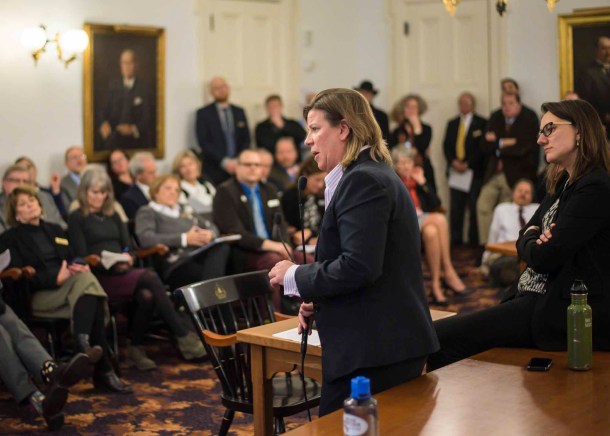
Lawmakers from tourist towns have banded together in a new group called the tourism caucus, and they plan to ask lawmakers this year to raise spending for tourism marketing by half a million dollars.
Vermont’s tourism budget has been stuck at about $3 million for six years, said Amy Spear, vice president for tourism at the Vermont Chamber of Commerce. Meanwhile, close competitors like Maine and New Hampshire are putting more money into marketing, enabling them to nibble away at Vermont’s share of visitors and dollars.
“We know we have the best fall foliage, but when New Hampshire is spending double what Vermont is to tell the world they have the best foliage, our voice is muted,” Spear said Thursday.
Vermont tourism operators and their supporters will hold a tourism industry advocacy day at the Statehouse Jan. 15. As part of that effort, proponents for raising the marketing budget will testify before the Senate Committee on Economic Development, Housing and General Affairs. Rep. Heidi Scheuermann, R-Stowe, said she plans to introduce an appropriation request that has about 25 co-sponsors, most of them members of the tourism caucus she started last year.
Tourism operators see themselves entering a heated contest for state money. Last year, lawmakers considered raising the rooms and meals tax collected by tourism operators from 9% to 10% to help pay for cleaning up Lake Champlain.
“Tourism is a huge driver for the state, and it’s usually the first place legislators try to tap when more funds are needed to carry out other initiatives,” said Brian Mulcahy of the Rabbit Hill Inn in Waterford. Mulcahy is on the board of the Vermont Inn and Bed & Breakfast Association.
Scheuermann who hails from one of the state’s biggest tourism centers — Stowe — is a leader in that contest. She rallied lawmakers who have an interest in tourism last year and found so many with similar interests that she decided to create the tourism caucus. The group had its first meeting Wednesday. Other founding members include Reps. Kathleen James, D-Manchester; Laura Sibilia, I-Dover; Kelly Pajala, I-Londonderry; Jim Harrison, R-Chittenden; John Killacky, D-South Burlington; and Charles Kimbell, D-Woodstock.

Scheuermann said in order to be heard at budget time, tourism needs a loud and focused voice. That’s what she hopes to create with the caucus. The industry is competing for lawmakers’ attention with other compelling matters like climate change and health care, she said.
“Last year I thought it would be good if we actually put faces to names and brought people to the Statehouse to share with the legislators how important the industry is to them, both employees and their families,” she said.
Field of competitors grows
Vermont as a tourist destination is also facing ever-more-stiff competition as information and travelers move around an increasingly global marketplace. Vermont competes for visitors not only with neighbors like Maine and New Hampshire, but with big western states like Colorado and Utah that appeal to outdoorsy types, Scheuermann said.
“People can go anywhere now,” she said. “It’s easy.”
Maine’s annual tourism marketing budget is $17 million and New Hampshire’s is $9.4 million, Spear said. Scheuermann said Colorado’s is $20 million and Utah’s is $27 million. Massachusetts has more than $13 million to work with.
Vermont’s annual tourism budget is $3 million, and the tourism caucus wants the state to spend $500,000 more.
Scheuermann dismissed comparisons that show those states also are much larger than Vermont, in most cases in land mass and in all by population. New Hampshire, the smallest, has 1.3 million residents compared to Vermont’s 625,000. Colorado has 5.7 million.
“They are (larger), but they are still our competitor states,” said Scheuermann. “$3 million is still a measly amount of money.”
Market share erosion
Meanwhile, Vermont is losing market share to its neighbors, Scheuermann and Spear said. While Vermont’s tourism revenues have been rising in recent years, those in neighboring states have risen faster. New Hampshire has been leveraging “live free,” taken from its “live free or die” license plate slogan, in YouTube videos and a Boston advertising campaign. That state said in its 2017 annual report that marketing to baby boomers in Florida, North Carolina, Chicago, and Dallas/Fort Worth increased visits to its website 300%.
The extra $500,000 in Vermont would be used only for destination marketing, not for overhead and operations at the Vermont Department of Tourism and Marketing. Right now, of the $3 million that the state spends on tourism, $1 million is spent on the department and $2 million on destination marketing, Spear said.
The Vermont Chamber’s lobbyists have met with more than 30 lawmakers in the last few months to talk to them about the importance of marketing, Spear said.
In its mission statement, the tourism caucus vows to seek nonpartisan solutions, value and protect Vermont’s brand and reputation, and never underestimate the competition. The group plans to meet every Thursday.
“Most every community in Vermont has an important link to tourism,” Scheuermann said.
